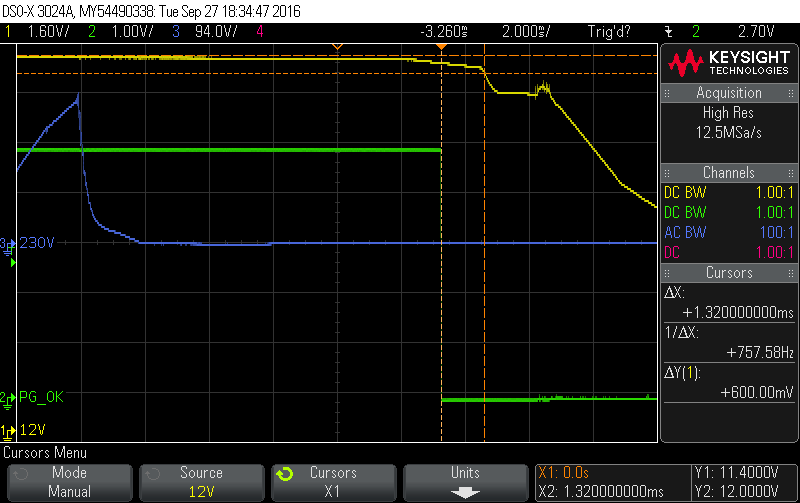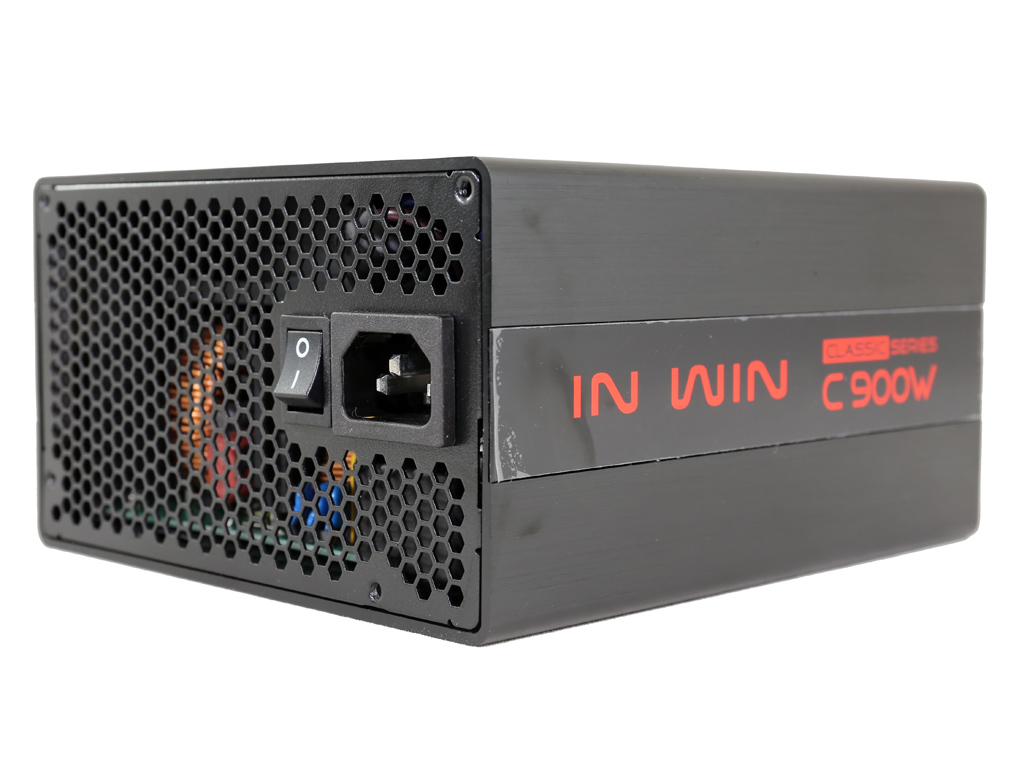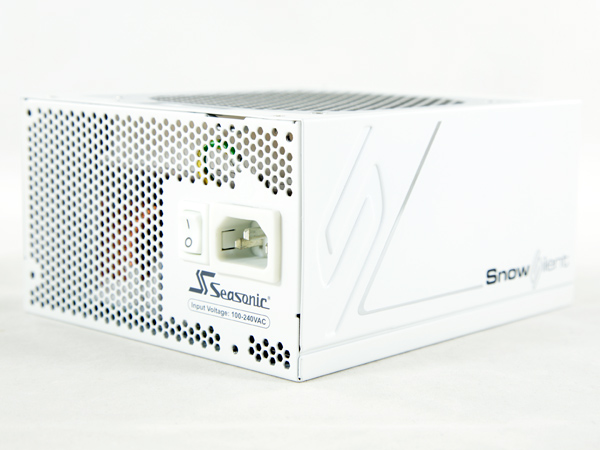In Win Classic Series C 900W PSU Review
In Win's Classic series consists of only two members featuring 750 W and 900 W capacities. The C900 is our test subject today. Besides a great finish and good looks, it promises reliable and quiet operation, along with high efficiency.
Why you can trust Tom's Hardware
Load Regulation, Hold-Up Time, And Inrush Current
To learn more about our PSU tests and methodology, please check out How We Test Power Supply Units.
Primary Rails And 5VSB Load Regulation
Load Regulation testing is detailed here.








Hold-Up Time
Our hold-up time tests are described in detail here.







Our measured hold-up time is less than what's required. We expected this since the bulk caps' combined capacity is low for this unit's capacity. At least the power-good signal is accurate.
Inrush Current
For details on our inrush current testing, please click here.


The registered inrush current with both voltage inputs is low for a 900 W PSU.
Load Regulation And Efficiency Measurements
The first set of tests reveals the stability of the voltage rails and the PSU's efficiency. The applied load equals (approximately) 10 to 110 percent of the maximum load the supply can handle, in increments of 10 percentage points.
Get Tom's Hardware's best news and in-depth reviews, straight to your inbox.
We conducted two additional tests. During the first, we stressed the two minor rails (5V and 3.3V) with a high load, while the load at +12V was only 0.1 A. This test reveals whether a PSU is Haswell-ready or not. In the second test, we determined the maximum load the +12V rail could handle with minimal load on the minor rails.
| Test # | 12V | 5V | 3.3V | 5VSB | DC/AC (Watts) | Efficiency | Fan Speed | Fan Noise | Temps (In/Out) | PF/AC Volts |
|---|---|---|---|---|---|---|---|---|---|---|
| 1 | 5.518A | 1.964A | 1.970A | 1.000A | 89.76 | 88.06% | 290 RPM | 21.2 dB(A) | 37.73 °C | 0.979 |
| 12.353V | 5.099V | 3.345V | 4.992V | 101.93 | 41.76 °C | 115.1V | ||||
| 2 | 12.112A | 2.949A | 2.969A | 1.204A | 179.58 | 91.13% | 315 RPM | 21.9 dB(A) | 38.10 °C | 0.982 |
| 12.278V | 5.081V | 3.332V | 4.977V | 197.05 | 42.82 °C | 115.1V | ||||
| 3 | 19.101A | 3.456A | 3.493A | 1.410A | 269.80 | 91.76% | 465 RPM | 26.5 dB(A) | 39.02 °C | 0.990 |
| 12.235V | 5.066V | 3.319V | 4.961V | 294.04 | 43.89 °C | 115.1V | ||||
| 4 | 26.099A | 3.954A | 3.989A | 1.615A | 359.59 | 91.68% | 650 RPM | 30.2 dB(A) | 40.21 °C | 0.994 |
| 12.201V | 5.052V | 3.307V | 4.945V | 392.23 | 45.33 °C | 115.1V | ||||
| 5 | 32.791A | 4.970A | 5.010A | 1.825A | 449.56 | 91.26% | 850 RPM | 33.2 dB(A) | 42.05 °C | 0.995 |
| 12.170V | 5.033V | 3.291V | 4.929V | 492.62 | 47.49 °C | 115.1V | ||||
| 6 | 39.515A | 5.983A | 6.040A | 2.035A | 539.56 | 90.64% | 1000 RPM | 35.2 dB(A) | 43.02 °C | 0.996 |
| 12.142V | 5.013V | 3.276V | 4.909V | 595.27 | 48.65 °C | 115.1V | ||||
| 7 | 46.264A | 7.012A | 7.079A | 2.245A | 629.47 | 89.85% | 1130 RPM | 36.2 dB(A) | 43.73 °C | 0.997 |
| 12.113V | 4.991V | 3.263V | 4.892V | 700.58 | 49.60 °C | 115.1V | ||||
| 8 | 53.035A | 8.049A | 8.132A | 2.460A | 719.38 | 88.95% | 1210 RPM | 36.7 dB(A) | 44.13 °C | 0.997 |
| 12.086V | 4.970V | 3.247V | 4.874V | 808.78 | 50.47 °C | 115.1V | ||||
| 9 | 60.273A | 8.580A | 8.694A | 2.464A | 809.40 | 88.12% | 1210 RPM | 36.7 dB(A) | 44.86 °C | 0.997 |
| 12.059V | 4.953V | 3.231V | 4.863V | 918.56 | 51.54 °C | 115.1V | ||||
| 10 | 67.280A | 9.117A | 9.230A | 3.099A | 899.19 | 87.14% | 1210 RPM | 36.7 dB(A) | 45.81 °C | 0.997 |
| 12.032V | 4.937V | 3.217V | 4.832V | 1031.85 | 52.88 °C | 115.1V | ||||
| 11 | 74.919A | 9.138A | 9.261A | 3.108A | 989.09 | 86.44% | 1210 RPM | 36.7 dB(A) | 46.30 °C | 0.997 |
| 12.005V | 4.925V | 3.206V | 4.823V | 1144.20 | 53.70 °C | 115.1V | ||||
| CL1 | 0.098A | 12.011A | 12.005A | 0.003A | 101.23 | 83.44% | 1030 RPM | 35.5 dB(A) | 43.52 °C | 0.978 |
| 12.327V | 5.019V | 3.309V | 5.006V | 121.32 | 49.41 °C | 115.1V | ||||
| CL2 | 74.953A | 1.003A | 1.003A | 1.002A | 915.41 | 87.79% | 1210 RPM | 36.7 dB(A) | 45.91 °C | 0.997 |
| 12.037V | 5.001V | 3.249V | 4.915V | 1042.79 | 52.88 °C | 115.1V |
Load regulation is mediocre and way behind the competition. In Win focused more efficiency and ripple suppression, but didn't pay enough attention to load regulation. In order to provide more than 12 V under any load, the +12V rail has a nominal voltage that exceeds 12.35 V during the 10% load test. We want all rails to be close to the voltages defined by the ATX spec, so we don't agree with overvoltage tricks.
As far as efficiency is concerned, the corresponding 80 PLUS Platinum requirement is satisfied in the 20% load test. This is not the case, however, for the 50% and full load tests, where the unit's efficiency is significantly below the specified thresholds. In general, the only positives we come away with are low noise and the PSU's ability to deliver full power under high operating temperatures. Those just aren't enough to keep us happy.
Current page: Load Regulation, Hold-Up Time, And Inrush Current
Prev Page A Look Inside And Component Analysis Next Page Efficiency, Temperature, And Noise
Aris Mpitziopoulos is a contributing editor at Tom's Hardware, covering PSUs.


